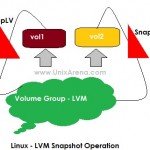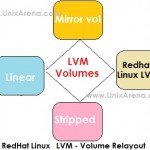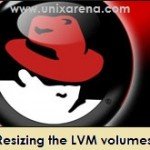In UnixArena Tutorial series, Here we are going to see about Linux’s Logical volume manager which is default volume manage on all of the Linux flavors which are available now a days in market.In this tutorial, you will learn how to integrate, operate, LVM on Redhat Linux. This training provides instruction on operational management procedures […]
Tutorials
Redhat Linux – LVM Volume Attributes
Redhat Linux’s Logical volume Manager has many attributes which are available for controlling the behavior LVM objects or to changing the default values of LVM. We may not use those attributes very often in typical production environment but knowing is not a bad thing. As a Unix/Linux admin,we should have capability to explain each and every field of […]
Linux LVM – How to take volume snapshot
In this LVM tutorial series, LVM snapshot topic is an important one and it’s one of the must know feature of Redhat Linux’s LVM. Volume snapshot is very useful to take database backup in consistent state without shutting down the database.If you take database backup without halting it,then that will be leading to an inconsistent DB […]
Redhat Linux – LVM Volumes Re-layout
In Linux, Logical volume’s layouts need to be changed according to the importance of data and performance of the volume. For example,If the current volume layout is mirrored and that volume’s data doesn’t update very frequently then daily backup may enough for the applications in case of disk failure.In these cases, you may get a […]
Linux LVM – Re-sizing the Logical Volume
In LVM, logical volumes size can be increased or decreased depends on our needs. Logical volume can be shirked/reduced using “lvreduce” command but this will not reduce the filesystem. You need to reduce the filesystem before reducing the logical volume. Logical volume can be extended/increased using “lvextend” command.Once you have extended the logical volume ,then […]
Linux LVM – Volume Creation & Operations
As of now we have seen physical volume administration and volume group administration on this Linux’s LVM tutorial series.Logical volume is the top most virtual object in the LVM. Once you have constructed physical volume and volume group,the next step will creating the logical volume and mount the filesystem for storing the data.Here we will […]
Linux – LVM – Volume Group Operations
We have already seen the basics of logical volume manager structure on the previous article.Here we are going to see about Logical volume manager’s volume group operations and management. Volume group is high level container in LVM which contains one or more physical disk or LUNS. A volume group can span in to multiple disks, whether […]
How to Install LVM on Linux and Disk Operations
LVM will be installed by default on Redhat Linux installation.But sometimes if you select the minimum package installation method,LVM will not be installed.So you need to install LVM package separately .Here we will see the LVM installation method and if its already installed how to verify it .Logical volume manager has two versions and those […]
Solaris 11 – ZFS Must known features
In this ZFS tutorial series,Here we are going to see about new features of ZFS and it’s usage in real production environment. Oracle is continuously developing ZFS and they brought some of the nice features in to Solaris 11 ZFS . Here we are mainly focusing on ZFS deduplication and ZFS encryption mechanisms. ZFS Deduplication is the process of […]
ZFS – ZPOOL Cache and Log Devices Administration
In this ZFS training/tutorial series,this article will talk about ZFS performance issues.If you didn’t tune the system according to the application requirement or vise-verse,definitely you will see the performance issues.For an example ,some of the applications may have more read requests than write and databases sends more write requests than read.So according the application,you need […]




